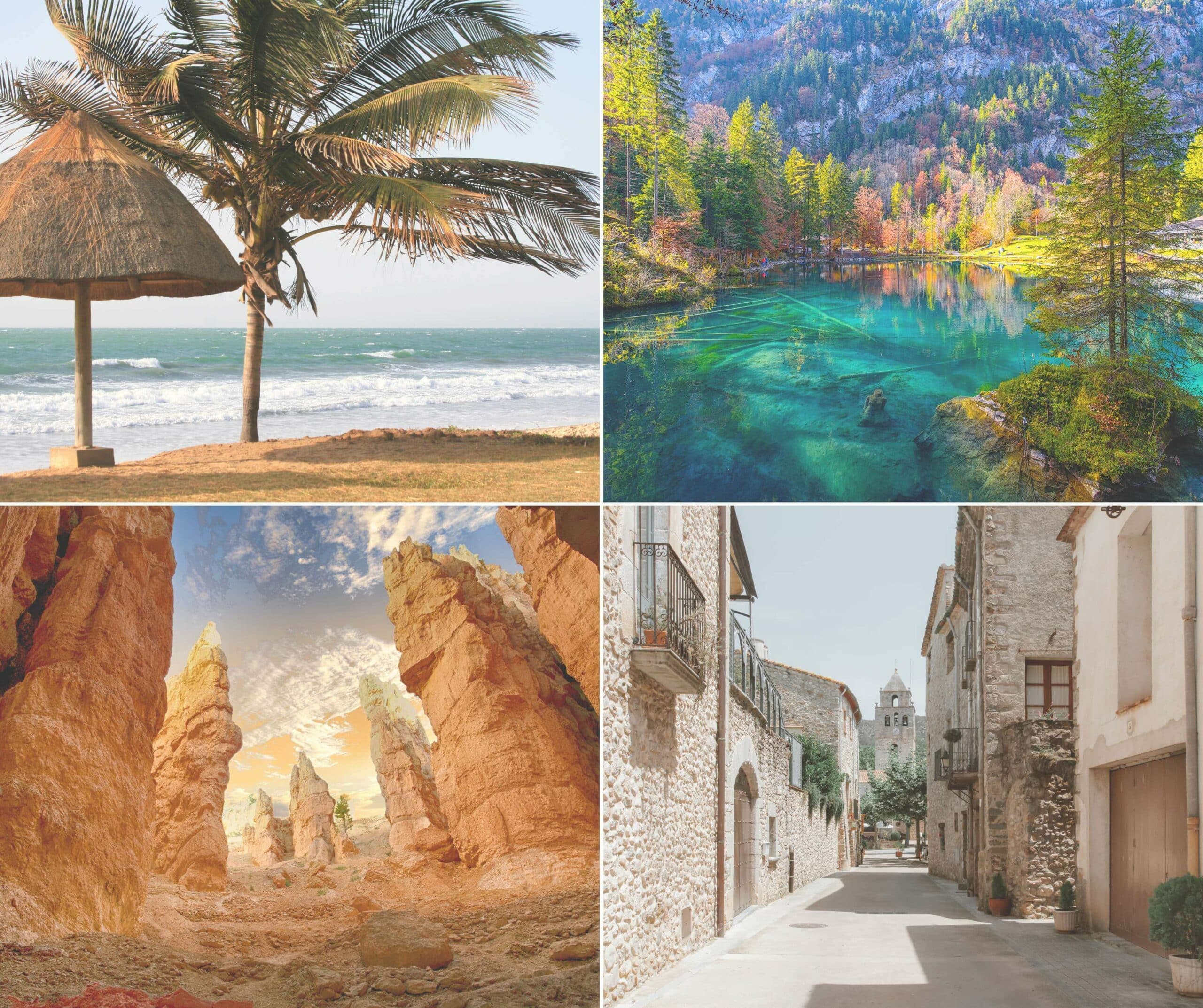Hidden Gems: Discover the World’s Best-Kept Travel Secrets – it’s more than just a catchy title; it’s a passport to adventure. Forget overcrowded tourist traps and Instagram-saturated landscapes. This journey dives deep into the world’s most captivating hidden corners, uncovering destinations that whisper stories instead of shouting them. We’ll explore what truly defines a “hidden gem,” weigh the pros and cons of off-the-beaten-path travel, and equip you with the tools to plan your own unforgettable escape.
Get ready to ditch the crowds and embrace the extraordinary.
From the sun-drenched beaches of secluded islands to the snow-capped peaks of uncharted mountains, we’ll reveal destinations that promise unique experiences. We’ll delve into the importance of sustainable tourism, ensuring these precious places remain pristine for generations to come. This isn’t just about finding a place on a map; it’s about connecting with authentic cultures, immersing yourself in breathtaking scenery, and creating memories that will last a lifetime.
So, are you ready to uncover your next adventure?
Defining “Hidden Gems” in Travel: Hidden Gems: Discover The World’s Best-Kept Travel Secrets

So, you’re dreaming of escaping the tourist hordes and discovering someplace truly unique? Let’s dive into what makes a travel destination a “hidden gem,” and not just another overcrowded postcard. It’s more than just a lack of billboards; it’s about an experience.Hidden gems aren’t simply places that haven’t beendiscovered* yet; they’re places that maintain a sense of authenticity and local character, even as they welcome visitors.
They offer a more intimate and less commercialized experience compared to major tourist hotspots. Think less selfie sticks, more genuine human connection. The key is a balance – enough infrastructure to be accessible, but not so much that it overshadows the destination’s unique charm.
You also will receive the benefits of visiting Pentingnya Fleksibilitas dalam Proses Self-Improvement today.
Characteristics of Hidden Gem Destinations
Hidden gems typically possess several key traits. They offer a unique cultural experience, often deeply rooted in local traditions and lifestyles. The landscapes are usually stunning and relatively untouched by mass tourism, offering a sense of escape and tranquility. Furthermore, the pace of life is usually slower and more relaxed, allowing for deeper immersion in the local culture.
Obtain recommendations related to Langkah Mengembangkan Kepedulian terhadap Kesehatan Mental that can assist you today.
Finally, the level of commercialization is minimal, meaning you’ll encounter fewer souvenir shops and more authentic local businesses.
Examples of Hidden Gem Destinations by Region
Let’s explore some real-world examples to solidify this definition. These aren’t necessarily completely unknown, but they offer a less crowded and more authentic experience than many of their more famous counterparts.
Hidden Gem Destinations Table
This table provides a structured overview of some hidden gems, highlighting their unique features and accessibility.
| Region | Destination | Unique Feature | Accessibility |
|---|---|---|---|
| Asia | Hoi An, Vietnam | Beautifully preserved ancient town with tailor shops and delicious street food. | Easy to reach by air and well-connected internally. |
| Europe | Hallstatt, Austria | Picturesque village nestled on a lake, surrounded by stunning mountains. | Accessible by train and car, but can be crowded during peak season. |
| South America | Salento, Colombia | Colorful coffee region town, surrounded by lush landscapes and offering opportunities for hiking and birdwatching. | Accessible by bus from major cities, but some areas require more rugged travel. |
| Africa | Chefchaouen, Morocco | Blue-washed buildings cascading down the mountainside, offering a unique visual experience. | Relatively easy to access by bus from Fes or Tangier. |
| North America | Banff National Park, Canada (lesser-known trails) | Stunning mountain scenery with numerous hiking trails offering varying levels of difficulty, far from the main tourist areas. | Requires a car to access many of the trails; some trails are challenging. |
Sustainable and Responsible Travel to Hidden Gems

Discovering hidden gems is all about experiencing the unique beauty and culture of lesser-known destinations. But with the rise of adventure travel and social media’s spotlight, even the most secluded spots face the potential for overcrowding and environmental damage. Sustainable tourism isn’t just a buzzword; it’s crucial for preserving these places for future generations and ensuring the well-being of the communities that call them home.The influx of tourists, while potentially boosting local economies, can also have detrimental effects.
Increased traffic can damage fragile ecosystems, leading to habitat loss and disruption of wildlife. The demand for resources like water and energy can strain local infrastructure, and the introduction of waste can pollute pristine environments. Furthermore, the cultural impact can be significant, with traditional ways of life potentially being disrupted or even commodified for the benefit of tourists.
For example, the over-tourism of Cinque Terre in Italy led to significant environmental degradation and strained local resources, highlighting the importance of responsible travel practices.
Minimizing Environmental Impact, Hidden Gems: Discover the World’s Best-Kept Travel Secrets
Responsible travel starts with minimizing your environmental footprint. This involves making conscious choices throughout your trip, from planning to departure. It’s about being mindful of your consumption and leaving a destination better than you found it.
- Reduce your carbon footprint: Opt for eco-friendly transportation options like trains or buses instead of flying whenever possible. Consider carbon offsetting programs to compensate for unavoidable emissions.
- Conserve water and energy: Be mindful of your water usage in accommodations and limit energy consumption by turning off lights and appliances when not in use.
- Reduce waste: Pack reusable water bottles, shopping bags, and food containers to reduce plastic waste. Support local businesses that prioritize sustainability and minimize packaging.
- Respect wildlife and natural habitats: Avoid disturbing wildlife or damaging natural environments. Stick to designated trails and leave no trace behind. Remember, observing wildlife from a distance is key to preserving their natural behavior.
Supporting Local Communities
Beyond environmental responsibility, sustainable tourism emphasizes supporting local communities. This involves actively engaging with the local culture and economy in a way that benefits the residents, not just the tourists.
- Stay in locally owned accommodations: Choose guesthouses, homestays, or eco-lodges run by local people. This helps inject money directly into the community.
- Eat at local restaurants and buy local products: Support local farmers and artisans by purchasing their products and trying local cuisine. This helps preserve traditional practices and boosts the local economy.
- Learn basic phrases in the local language: Showing respect for the local culture goes a long way. A simple “hello” or “thank you” can create a positive interaction.
- Respect local customs and traditions: Be mindful of local customs and dress appropriately. Avoid actions that could be considered disrespectful or intrusive.
- Support local conservation efforts: Consider donating to or volunteering with local organizations working to protect the environment and preserve cultural heritage. Examples include organizations working to protect endangered species or preserve ancient ruins.
The Future of Hidden Gem Tourism

The rise of hidden gem tourism presents a fascinating paradox. While offering incredible opportunities for both travelers and local communities, it also poses significant challenges. The very nature of these destinations – their unspoiled beauty and relative isolation – makes them vulnerable to the pressures of increasing popularity. Balancing the desire for exploration with the need for preservation is the key to ensuring a sustainable future for these unique places.The delicate ecosystem of hidden gem destinations is at risk.
Increased tourism can lead to infrastructure strain, environmental degradation, and a dilution of the authentic cultural experiences that draw visitors in the first place. Overtourism, a phenomenon increasingly observed in once-secluded locations, can quickly transform a tranquil paradise into a crowded, commercialized space, losing the very charm that made it a hidden gem. This is not merely a hypothetical concern; we’ve seen this play out in countless destinations around the world, from once-pristine beaches overrun with resorts to ancient villages struggling under the weight of mass tourism.
Balancing Tourism Development and Environmental Protection
Strategies for sustainable tourism development in hidden gem destinations are crucial. This involves a multi-pronged approach, focusing on responsible infrastructure development, stringent environmental regulations, and robust community involvement. Imagine a small island community investing in eco-friendly accommodations and transportation, implementing waste management systems that minimize environmental impact, and training local guides to educate tourists about the importance of conservation.
This model prioritizes the long-term health of the environment and the well-being of the community, ensuring that tourism benefits both. Effective collaboration between government agencies, local communities, and tourism operators is vital in developing and implementing these strategies. This collaborative approach is exemplified by initiatives like the Global Sustainable Tourism Council, which provides guidelines and certifications for sustainable tourism practices.
Technology’s Role in Shaping Hidden Gem Tourism
Technology is playing, and will continue to play, a transformative role in both the discovery and accessibility of hidden gems. Sophisticated mapping tools and online travel platforms already allow travelers to uncover lesser-known destinations and plan their trips more effectively. However, the challenge lies in ensuring that this technology promotes sustainable tourism rather than contributing to overtourism. For instance, using technology to spread awareness about responsible travel practices, such as promoting slow travel, supporting local businesses, and minimizing one’s environmental footprint, is key.
Furthermore, the use of AI-powered tools to predict tourist flows and manage crowds can help to mitigate the negative impacts of overtourism, allowing destinations to better prepare for and manage the influx of visitors. Imagine a system that analyzes real-time data to predict potential overcrowding in a particular area, allowing authorities to implement strategies to alleviate congestion and protect sensitive areas.
Unveiling the world’s hidden gems isn’t just about ticking off destinations on a bucket list; it’s about forging a deeper connection with the planet and its diverse cultures. By embracing responsible travel and venturing beyond the well-trodden paths, we not only enrich our own lives but also contribute to the preservation of these extraordinary places. So, pack your bags, open your mind, and embark on a journey to discover the unexpected.
The world is waiting to surprise you.
No responses yet